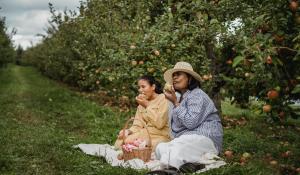
With late winters come school delays, temperature drops, and long lines clearing out aisles at the grocery store. For many of us, winter nights are accompanied by hot cocoa and cozy blankets. But how does winter look for people living with food insecurity? How are their food needs met?
According to Feeding America, In 2020, an estimated 1 in 8 Americans were food insecure, equating to over 38 million Americans, including almost 12 million children. Food insecurity increases in winter. Food insecurity is not only a health problem but also a policy issue.
With increases in home heating and cooling costs in many parts of the U.S., it is important to understand the extent to which households make tradeoffs between heating and cooling costs and other basic needs that affect their food security.
“In high-cooling states, the odds of exceptionally low food security for poor, elderly only households were 27% higher in the summer than in the winter. In high-heating states, the pattern was reversed for such households; the odds of exceptionally low food security were 43% lower in the summer”.
There are several ways to prepare to restore communities that are suffering from food security. In a recent interview with the founder of the Wombyn’s Wellness Garden, Roberta Eaglehorse- Ortiz, she shares that to help her community meet food needs in the winter, "It is all about Preservation and Dry storage.” Harvest work does not have to go to waste in the winter months. Food preservation and dry storage are sustainable ways to keep eating fresh long after the harvest season. Many dry storage facilities can provide warehouses, containers, and rooms with specific air temperature and lighting levels. These are also things you can manage at home to prepare for the winter months.
Here are 5 ways you can preserve and store your goods:
-
Dry Herbs: Herbs are quick and easy to dry and store for year-round use. They can be dried in a dehydrator or an oven, or even air-dried. When air drying, hang small bundles of clean herbs in a dry, airy place, out of direct sunlight. Herbs are sufficiently dried and ready for storage when they are crisp and brittle.
-
Dry Salting: When fermenting vegetables, dry salting refers to massaging or mixing salt into fresh produce to draw out the liquid from the produce naturally. The liquid that is created through dry salting is the natural brine you will ferment with.
-
Sealing: Sealing is one of the methods that does require a particular piece of equipment, but home food sealers are generally inexpensive appliances. This method merely seals the air away from the food to prevent spoilage. You can combine sealing with freezing or drying. Green America suggests seal containers when performing this method of preservation.
-
Canning: Canning is a process of heating and sealing foods (generally in glass jars), which kills the bacteria and preserves the food. Canned foods usually last for years. Canning is useful for many types of foods, including vegetables, fruits, meats, and even seafood.
-
Below the Brine: When fermenting produce, it’s important to keep the fruits and vegetables below the brine level. Brining is a salt solution, and traditional brining is done by soaking ingredients, predominantly meat or fish, in brine prior to cooking. Anything above the brine is susceptible to mold. If everything is held below the brine (usually with the assistance of a fermentation weight or other food-safe weight alternative), it will be safe in an oxygen-free (anaerobic) environment.
Little Free Pantry
For more community needs that are immediate and local, there are pantries, soup kitchens, and churches such as the Little Free Pantry. The Little Free Pantry was started in 2016 by Jessica McClard. Jessica wanted to raise awareness of food insecurity while connecting and helping her neighbors. These pantries have now gone global and may be found near you. If you aren't able to find a pantry near you, there is also an option to build a pantry for your community, much like the "Little Free Libraries" you may have spotted in a neighbor's lawn. When winterizing the pantry, community leaders ask for more nonperishable items. The food can freeze or mold during the winter months. There are many ways to help the community by building or contributing to your local food pantry.
Don’t Buy the Shelves Out
If you're hitting the grocery store to prepare for winter weather, please just buy what you need and leave some for others!
You may have noticed empty shelves in some stores due to national supply chain issues, but there is no need to buy more than you normally would. pic.twitter.com/RcCNNa4Zj4
— DC Homeland Security & Emergency Management (@DC_HSEMA) January 15, 2022
When preparing for winter, most of us make our first stop at the grocery store or local market. It is common in moments of high stress or panic to clear shelves and overstock our cabinets- don't. Taking more than you need at the grocery store does more harm than good. Shopping in moderation is beneficial to families that face food insecurity.






